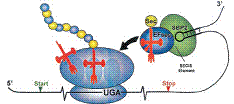Biochemistry, Department of

Vadim Gladyshev Publications
Document Type
Article
Date of this Version
1-25-2008
Abstract
Although dietary selenium (Se) deficiency results in phenotypes associated with selenoprotein depletion in various organs, the brain is protected from Se loss. To address the basis for the critical role of Se in brain function, we carried out comparative gene expression analyses for the complete selenoproteome and associated biosynthetic factors. Using the Allen Brain Atlas, we evaluated 159 regions of adult mouse brain and provided experimental analyses of selected selenoproteins. All 24 selenoprotein mRNAs were expressed in the mouse brain. Most strikingly, neurons in olfactory bulb, hippocampus, cerebral cortex, and cerebellar cortex were exceptionally rich in selenoprotein gene expression, in particular in GPx4, SelK, SelM, SelW, and Sep15. Over half of the selenoprotein genes were also expressed in the choroid plexus. A unique expression pattern was observed for one of the highly expressed selenoprotein genes, SelP, which we suggest to provide neurons with Se. Cluster analysis of the expression data linked certain selenoproteins and selenocysteine machinery genes and suggested functional linkages among selenoproteins, such as that between SelM and Sep15. Overall, this study suggests that the main functions of selenium in mammals are confined to certain neurons in the brain.
Gladyshev JBC 2008 Comparative--supple_table.xls


Comments
Published in THE JOURNAL OF BIOLOGICAL CHEMISTRY VOL. 283, NO. 4, pp. 2427–2438, January 25, 2008. Copyright 2008. Used by permission. Printed in the U.S.A.